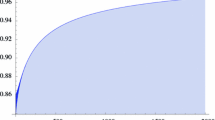Abstract
Let \(U_{n}\) denote the nth Cohen number. Some combinatorial properties for \(U_{n}\) have been discovered. In this paper, we prove the ratio log-concavity of \(U_{n}\) by establishing the lower and upper bounds for \(\frac{U_{n}}{U_{n-1}}\).
Similar content being viewed by others
1 Introduction
An infinite sequence \(\{a_{n}\}_{n=0}^{\infty}\) is said to be log-concave (respectively, log-convex) if for any positive integer n,
Furthermore, a positive sequence \(\{a_{n}\}_{n=0}^{\infty}\) is said to be ratio log-concave if the sequence \(\{\frac{a_{n+1}}{a_{n}}\}_{n=0}^{\infty}\) is log-concave. The aim of this paper is to prove the ratio log-concavity of the Cohen numbers. The nth Cohen number was first introduced by Cohen [1] which is defined by
with \(U_{0}=1\) and \(U_{1}=12\), where
and
In [2], Zudilin proved that \(D_{n} U_{n}\) is an integer where \(D_{n}\) is the least common multiple of \(1, 2, \ldots, n\). Moreover, he conjectured some stronger inclusions that were finally proved by Krattenthaler and Rivoal [3]. In particular, they proved that
where the binomial coefficients \({a\choose b}\) are zero if \(b < 0\) or \(a < b\); see also [4].
Recently, the combinatorial properties of \(U_{n}\) were considered. Employing a criterion due to Xia and Yao [5], it is easy to prove the log-convexity of \(U_{n}\). Chen and Xia [6] proved the 2-log-convexity of \(U_{n}\), that is,
In this paper, we prove the ratio log-concavity of \(U_{n}\). The main results of the paper can be stated as follows.
Theorem 1.1
The sequence \(\{U_{n}\}_{n=0}^{\infty}\) is ratio log-concave, namely, for \(n\geq2\),
2 Lower and upper bounds for \(\frac{U_{n}}{U_{n-1}}\)
In order to prove Theorem 1.1, we first establish the lower and upper bounds for \(\frac{U_{n}}{U_{n-1}}\).
Lemma 2.1
For \(n\geq5\),
where
Proof
We are ready to prove Lemma 2.1 by induction on n. It is easy to check that (2.1) is true when \(n = 5\) and \(n=6\). Suppose that Lemma 2.1 holds when \(n = m \geq5\), that is,
In order to prove Lemma 2.1, it suffices to prove that this lemma holds when \(n = m + 2\), that is,
where \(h(n)\), \(g(n)\), and \(l(n)\) are defined by (1.2), (1.3), and (2.2), respectively. Thanks to (2.5),
where \(\alpha(m)\) and \(\beta(m)\) are defined by
and
By (2.6) and the fact that \(\alpha(m)\beta(m)> 0\) for \(m\geq5\), we obtain (2.4). This completes the proof of Lemma 2.1 by induction. □
Lemma 2.2
For \(n\geq5\),
where
Proof
We also prove Lemma 2.2 by induction on n. It is easy to verify that (2.7) holds for \(n = 5\) and \(n=6\). Assume that Lemma 2.2 is true for \(n = m \geq5\), that is,
where \(u(m)\) is defined by (2.8). In order to prove Lemma 2.2, it suffices to prove that Lemma 2.2 is true when \(n = m + 2\), namely,
where \(h(n)\), \(g(n)\), and \(u(n)\) are defined by (1.2), (1.3), and (2.8), respectively. Thanks to (2.11),
where \(\varphi(m)\) and \(\psi(m)\) are defined by
and
By (2.12) and the fact that \(\varphi(m)\psi(m)> 0\) for \(m\geq5\), we arrive at (2.10). This completes the proof of Lemma 2.2 by induction. □
3 Proof of Theorem 1.1
In this section, we present a proof of Theorem 1.1.
Lemma 3.1
For \(n\geq5\),
where
Proof
Let \(h(n)\) and \(g(n)\) be defined by (1.2) and (1.3), respectively. It is easy to verify that, for \(n\geq5\),
where
Moreover, it is easy to check that, for \(n\geq0\),
and
where
and
It follows from (3.3)-(3.5) that, for \(n\geq0\),
and thus
which implies that, for \(n\geq5\),
Thanks to (1.1),
Lemma 3.1 follows from (3.8) and (3.9). This completes the proof. □
Lemma 3.2
For \(n\geq5\),
where \(f(n)\) is defined by (3.2).
Proof
It is easy to check that, for \(n\geq5\),
and
where
and thus
Furthermore, it is easy to check that, for \(n\geq0\),
and
where
Combining (3.11), (3.14), and (3.15) yields
It follows from (2.1), (2.7), (3.13), and (3.16) that, for \(n\geq5\),
which yields
In view of (1.1),
Lemma 3.2 follows from (3.17) and (3.18). This completes the proof. □
Now, we turn to the proof of Theorem 1.1.
Proof of Theorem 1.1
Replacing n by \(n-1\) in (3.10), we deduce that, for \(n \geq6\),
In view of (3.1) and (3.19), we deduce that, for \(n\geq 6\),
It is easy to verify that (3.20) also holds for \(2\leq n \leq 5\). This completes the proof of Theorem 1.1. □
References
Cohen, H: Accélération de la convergence de certaines récurrences linéaires. Sémin. Théor. Nombres 1980-1981, Exposé no. 16, 2 pages
Zudilin, W: An Apéry-like difference equation for Catalan’s constant. Electron. J. Comb. 10, #R14 (2003)
Krattenthaler, C, Rivoal, T: Hypergéométrie et fonction zêta de Riemann. In: Mem. Am. Math. Soc., vol. 186. Am. Math. Soc., Providence (2007)
Almkvist, G, Zudilin, W: Differential equations, mirror maps and zeta values. In: Yui, N, Yau, S-T, Lewis, JD (eds.) Mirror Symmetry V. AMS/IP Studies in Adv. Math., vol. 38, pp. 481-515. Am. Math. Soc., Providence (2007)
Xia, EXW, Yao, OXM: A criterion for the log-convexity of combinatorial sequences. Electron. J. Comb. 20(4), #P3 (2013)
Chen, WYC, Xia, EXW: The 2-log-convexity of the Apéry numbers. Proc. Am. Math. Soc. 139, 391-400 (2011)
Acknowledgements
This work was supported by the National Science Foundation of China (11526136).
Author information
Authors and Affiliations
Corresponding author
Additional information
Competing interests
The authors declare that they have no competing interests.
Authors’ contributions
All authors contributed equally to the writing of this paper. All authors read and approved the final manuscript.
Rights and permissions
Open Access This article is distributed under the terms of the Creative Commons Attribution 4.0 International License (http://creativecommons.org/licenses/by/4.0/), which permits unrestricted use, distribution, and reproduction in any medium, provided you give appropriate credit to the original author(s) and the source, provide a link to the Creative Commons license, and indicate if changes were made.
About this article
Cite this article
Liu, E.H., Jin, L.J. The ratio log-concavity of the Cohen numbers. J Inequal Appl 2016, 278 (2016). https://doi.org/10.1186/s13660-016-1217-7
Received:
Accepted:
Published:
DOI: https://doi.org/10.1186/s13660-016-1217-7



